#Lunar Module Descent Engine
Explore tagged Tumblr posts
Text
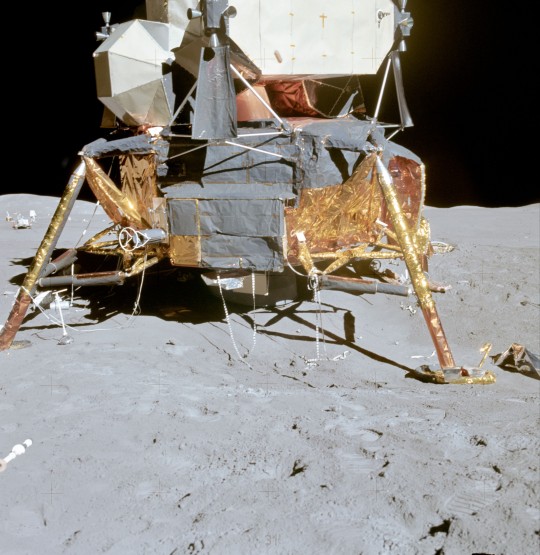
Southeast view of Apollo 15 Lunar Module (LM-10) Falcon, with the Lunar Roving Vehicle (LRV), Apollo Lunar Surface Experiments Package (ALSEP) and Hill 305 in the background. Photographed during the second Extravehicular Activity (EVA 2) of the Apollo 15 mission.
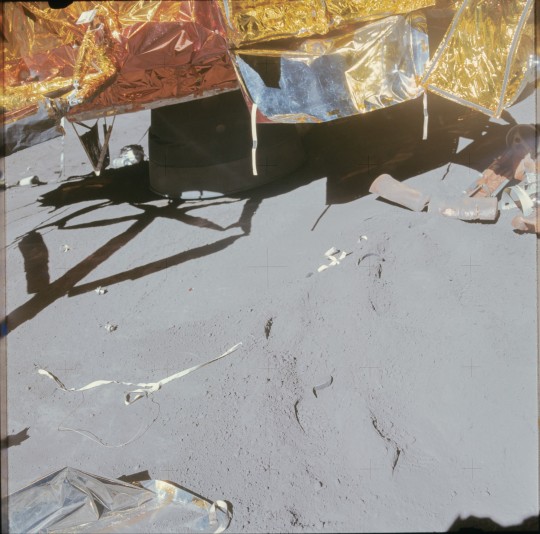
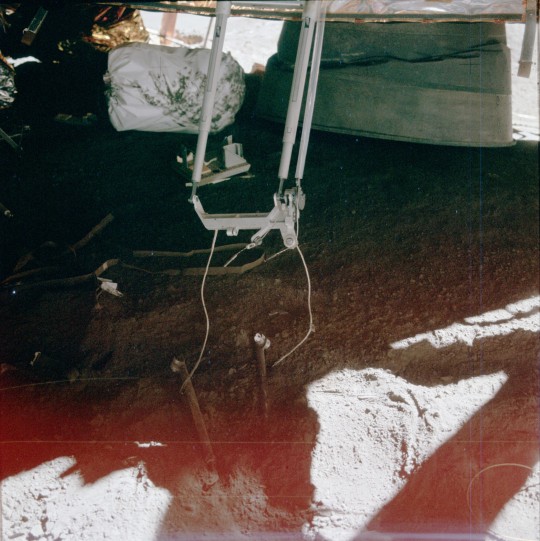
Decreased clearance led to buckling of the extended descent engine nozzle on the landing of Apollo 15.
"In order to extend landing payload weight and lunar surface stay times, the last three Apollo Lunar Modules were upgraded by adding a 10-inch (25 cm) nozzle extension to the engine to increase thrust. The nozzle exhaust bell, like the original, was designed to crush if it hit the surface. It never had during the first three landings, but did buckle on the first Extended landing, Apollo 15."
-information from Wikipedia: link
Date: August 1, 1971
NASA ID: AS15-87-11839, AS15-87-11842, AS15-88-11882
#Apollo 15#Lunar Module#LM-10#Falcon#NASA#Apollo Program#J-type mission#Moon Landing#Moon#Hadley–Apennine#Descent Propulsion System#Lunar Module Descent Engine#LMDE#Lunar descent stage propulsion#TRW VTR-10#Rocket Engine#August#1971#my post
35 notes
·
View notes
Photo

2024 December 14
Apollo 17's Moonship Image Credit: Apollo 17, NASA, (Image Reprocessing: Andy Saunders)
Explanation: Awkward and angular looking, Apollo 17's lunar module Challenger was designed for flight in the near vacuum of space. Digitally enhanced and reprocessed, this picture taken from Apollo 17's command module America shows Challenger's ascent stage in lunar orbit. Small reaction control thrusters are at the sides of the moonship with the bell of the ascent rocket engine underneath. The hatch allowing access to the lunar surface is seen at the front, with a round radar antenna at the top. Mission commander Gene Cernan is clearly visible through the triangular window. This spaceship performed gracefully, landing on the Moon and returning the Apollo astronauts to the orbiting command module in December of 1972. So where is Challenger now? Its descent stage remains at the Apollo 17 landing site in the Taurus-Littrow valley. The ascent stage pictured was intentionally crashed nearby after being jettisoned from the command module prior to the astronauts' return to planet Earth.
∞ Source: apod.nasa.gov/apod/ap241214.html
187 notes
·
View notes
Text
GETTING TO THE MOON

On the Apollo missions, the lunar module was in a compartment stage beneath the command module engines. Once the ship had reached a certain distance, that stage would separate and free the lunar module.

The command module would then dock with the lunar module. The spacecraft then continued on to lunar orbit in thesis configuration.
Upon arrival at the separation point, two astronauts would crawl through a pressurized tunnel from the command module into the lunar module. The third astronaut remained in the command module, orbiting above the moon.

The lunar module then separated and proceeded to its landing point. The lunar module (or LEM - Lunar Excursion Module, as it was referred to at this point) became home for the two astronauts during their brief stay on the moon.
-Apollo 11 stayed 21 hrs 36 mins
-Apollo 12 stayed 31.6 hrs
-Apollo 13 never landed
-Apollo 14 stayed 33 hrs
-Apollo 15 stayed 67 hrs
-Apollo 16 stayed 71 hrs
-Apollo 17 (the last men on the Moon) stayed just seconds shy of 75 hrs.

For departure the top half of the LEM, or ascent stage, would fire its rockets and ascend into lunar orbit to rendezvous with the command module. The descent stage was left behind on the lunar surface.
Once the ascent stage had docked with the command module the astronauts would transfer back. The ascent stage was then jettisoned, and all three astronauts rode the command module back to Earth to splashdown somewhere in the ocean.
Just a reminder of what REAL astronauts experienced back in the day. Meanwhile, in present times, everyone seems to be going ga-ga over a bunch of celebrities who central high and experienced a brief moment of zero-G.
#Apollo#command module#lunar module#LEM#Lunar Excursion Module#moon landing#it's real!#NASA#space travel#real space travel
9 notes
·
View notes
Text

Apollo Lunar Module Descent Engine
Cliff Steenhoff on Flickr
7 notes
·
View notes
Video
Descent to Fra Mauro by NASA on The Commons Via Flickr: This North American Rockwell artist's concept depicts the Apollo 13 Lunar Module (LM) descending to the Fra Mauro landing site as the Command and Service Module (CSM) remains in lunar orbit. Astronaut Thomas K. Mattingly II, the command module pilot, was to photograph the LM's descent from the CSM. For what was to be NASA's third lunar landing mission, astronauts James A. Lovell Jr., commander, and Fred W. Haise Jr., lunar module pilot, were to descend in the LM to explore the Moon. Mattingly was bumped from the crew three days before launch after being exposed to German measles, with backup command module pilot John "Jack" Swigert taking his place. Apollo 13 launched on April 11, 1970, with little fanfare. But two days into the mission, an oxygen tank onboard exploded, transforming Apollo 13 into a tense rescue mission that hinged on the ingenuity and grit of the crew, mission control, and NASA engineers. NASA Media Usage Guidelines Credit: NASA Image Number: S70-31898 Date: March 20, 1970
#artwork#artist depiction#artist conception#Moon#Moon Landing#Fra Mauro#Command Module#Lunar Module#apollo 13#Lunar Landing#painting#flickr#Mecha#Spacecraft#NASA
6 notes
·
View notes
Note
Absolutely love the 17776 au. Its such an interesting concept and im exited too see where it goes. Easily my favorite wn fic
🥺 your favourite? 🥺🥺 here's a little snippet of the next chapter just for you 🥰
...
Are you still there?
I’m sorry, it takes 11 days to charge enough for a message. I’m still here. I promise.
She sends this, what, after another week? A handful of days cupped in her palm like pebbles, like the baby teeth they wrestled from her mouth with too-big fingers and tossed into the wastepaper bin.
This Ava, who sits in a void the size of herself, has never seen a sunrise. She hasn’t yet invented stars, through there is one close enough and important enough that she’ll have to, soon.
per aspera ad astra
She’s weak, and small. A dim light too shy to shine but there, present as a cold shape in space, turning with her great metal wings casting no shadows. Not anywhere.
The light touches her, but not like that, not like a girl’s mouth and the hot wet progress of her tongue, down in the crease between thigh and oh god. fuck.
The light loves her maybe as much as that, as fervently but not as badly, lumens blushing over the white-tipped primaries, the mixed metaphor metacarpals of her body which is winged only in the sense that it soars.
They build satellites like this, in the afterimage of birds with wings that drink the light down the way you take a girl in your mouth. Ava’s not the same as them because so many are still cupped around Earth in a too-tight grip. Nothing is the same as it was.
would you recognise home, Ava? if it walked up to you and kissed you?
Ava’s old. She’s got that NASA decrepitude to her – built to be beautiful by accident, like the Apollo Lunar Module with her odd legs, her aluminium body drinking down dust. Bulky in her clothes, her tanks of aerozine 50 fuel, nitrogen tetroxide oxidizer, water, oxygen, helium… her pretty skirt of a descent engine.
They don’t tell children this, but they left this part behind on the moon.
Somewhere, out in the void that surrounds her, that is her, Ava senses a heat signature. With sticky fingers she reaches out and tries to touch it.
Stares at the light spilling out of them or through them. She is not the light but she is a light. Her fingers shock her almost half-awake.
These are real, at least. She puts them in her mouth and they taste like copper wires and nitrogen tetroxide, which tastes of equilibrium, of hypergolicity, of moon dust.
They taste like a prom date left behind on the moon, and whatever happened to her.
(nothing, if being lost can bear that description)(it cannot)
They feel like a girl’s fingers and Ava knows this because she has always been an open-mouthed thing. Call her hungry, call her awed, call her a slut.
Either way, you’ll know her by name.
19 notes
·
View notes
Text



I never cease to be amazed at the deniers who claim that the entire space program was and is a gigantic hoax. I hereby challenge ANY of them to prove their absurd claims. I don't mean by pointing to a photograph and simply saying "that's fake", or by using some ridiculous concatenation of imagined "facts". I mean empirical evidence that we can put our hands on.
And I find it interesting that the deniers for the most part weren't even born during the time of Mercury, Gemini and Apollo. I was - I saw it firsthand, I followed it religiously, I know people who worked in the space program. I have touched and handled hardware, including the Apollo 8 Command Module.
To all of the moon landings deniers, here are the answers to 10 of the most common moon-landing-denial stories, plus two bonus answers.
1. The flag is not blowing in the wind. Its top seam is held up by a spring-loaded rod, and the wrinkles are due to it being furled in a tight tube for transport and then shaken as the astronauts hammered it into the lunar surface. There was no wind because there is no air. This is on the moon.
2. There was no cameraman. Neil Armstrong's first steps were captured by a TV camera mounted on the equipment bay door of the Lunar Module. Later on, one of the astronauts moved the camera to a stand—you know, like a tripod?—to cover the whole landing site. Still photos were taken by Neil Armstrong using a Hasselblad medium-format camera loaded with 70mm Ektachrome film. The camera was attached to a bracket on Armstrong's chest pack. An additional time-lapse film was automatically shot using a 16mm data camera mounted in the LM window.
3. The footprints hold their shape because there is no air on the moon, not because the dirt ("regolith") is wet. The phenomenon is called "vacuum cementing," and it works especially well on the jagged edges of lunar dust particles.
4. There are no stars in the picture because the camera exposure was set for the lunar surface, the astronauts' suits, and the equipment, all of which were in bright sunlight. The stars are very, very dim. They would not show up without much longer exposures that would have left everything else completely washed out. I'm attaching a very good video clip from the Planetary Society which explains the phenomenon.
https://www.youtube.com/watch?v=hxwWfJQjyx0
5. There's no crater underneath the LM descent engine for several reasons. First, at touchdown the engine was throttled down to about 10 percent of its full thrust, and in the lunar gravity the LM weighed only ⅙ of its earth weight. (This is also one reason why the footpads didn't sink into the regolith; see #6.) Second, there's no air on the moon to hold the engine exhaust into a tight jet. The exhaust gasses expand as soon as they clear the engine bell and spread out very quickly. Third, the regolith below the engine blew away in straight lines due to the lack of air. The low lunar gravity meant the regolith travelled a long distance before falling back to the surface. There is a crater, but it's very shallow and difficult to see in the photos.
6. The footpads didn't sink into the regolith because they're 3 feet in diameter and the lunar module touched down very gently. This spread the weight over a broad area. On the other hand, the astronauts' boots (see #7) concentrated the astronaut's weight on a small area, so they left deeper, well-defined boot prints. The lunar surface at the Apollo 11 landing site had a thin layer of loose material with a hardened layer just beneath it. Other landing sites had more or less loose material.
7. The boot prints on the lunar surface don't match the boots in photos of the astronauts on earth because they're not the same boots. All three crew members on Apollo flights wore full pressure suits with boots. The two men who landed and walked on the moon wore an additional garment over their suits to protect against punctures and wear and tear. This over-garment had additional visors for their helmet and overshoes for walking on the moon. The overshoes had the tread pattern seen in lunar photos.
8. The astronauts' backpacks (Portable Life Support System or "PLSS,") did not need to carry enough oxygen for an 8-hour moonwalk because the PLSS was a closed system. Carbon dioxide breathed out by the astronauts went through a chemical filter that removed the carbon and recirculated the oxygen. Only a small amount of oxygen had to be added to make up for what the astronauts had burned in their bodies. There was also a smaller, emergency oxygen tank just in case.
9. The Van Allen radiation belts do not extend to the moon so they were not a problem while the astronauts were in lunar orbit or on the surface. They did pass through the Van Allen belts on the way to and from the moon, but the transits were just over an hour each way. The short time, plus the protection built into their spacecraft, meant the Apollo astronauts received no more radiation exposure than Space Shuttle or Space Station astronauts who never got near the Van Allen belts.
10. President Nixon did not simply pick up the phone, dial Mission Control, and then ask the receptionist to put him through to the Sea of Tranquility. The call went from the White House telephone exchange via the AT&T network to the Goddard Spaceflight Center near Washington, DC. Goddard routed the signal to the Manned Spaceflight Center (now the Johnson Space Center) in Houston. From there, it went via communications satellite to NASA’s installation at Honeysuckle Creek, Australia, which was the primary link between earth and the moon during the moon walk. It wasn’t routine, but the technology of patching telephone calls into radio networks was common in 1969.
And here’s a bonus of two more…
11. By the time the cameras on Apollo 11 got to the moon they weren’t “normal film cameras.” The live video used a custom-made Westinghouse television camera designed for minimum size, weight and power drain. Its frame rate was only 10 frames per second to squeeze the video signal into the available radio bandwidth. (Broadcast TV at the time was 29.97 frames per second.) Still photos were shot with a Hasselblad medium-format camera that was stripped down to save weight, and rebuilt with lubricants that could work in extreme temperatures and vacuum. The film was 70mm Ektachrome that used a special base developed by Kodak. It was lighter, thinner and stronger than regular films of the time. There was also a 16mm film camera mounted inside the lunar module taking time-lapse footage of the astronauts on the surface. It was meant to collect data, not take pretty pictures, and it could be set to shoot at different frame rates.
12. Finally, there were something like 400,000 people around the world involved with Project Apollo. In addition, the Apollo missions were tracked by the Soviet Union, Great Britain and probably several other nations. The idea that all of these people could be involved in a conspiracy to fake the missions, a conspiracy that has been maintained for more than 50 years, is improbable to say the least.
Thus endeth the lesson.
2 notes
·
View notes
Note
you mention the apollo guidance computer in your bio.
do you have any nerdy fun facts about it?
Thanks for the ask!
It's difficult to convey everything the AGC was, concisely, but here's some highlists:
In terms of size and power, it's comparable to the Apple II, but predates it by 11 years. There are some obvious differences in the constraints placed on the two designs, but still, that's pretty ahead of it's time.
The bare-bones OS written for the AGC was one of the first to ever implement co-operative multi-tasking and process priority management. This would lead problems on Apollo 11, when an erroneously deployed landing radar overloaded the task scheduler on Eagle during the Lunar landing (the infamous 1201/1202 program alarms). Fortunately, it didn't end up affecting the mission, and the procedures were subsequently revised/better followed to avoid the situation ever reoccurring.
Relatedly, it was also designed to immediately re-boot, cull low-priority tasks, and resume operations following a crash -- a property essential to ensuring the spacecraft could be piloted safely and reliably in all circumstances. Many of the reliability-promoting techniques used by Apollo programmers (led by Margaret Hamilton, go women in STEM) went on to become foundational principles of software engineering.
Following the end of the Apollo, Skylab, and Apollo-Soyuz missions, a modified AGC would be re-purposed into the worlds first digital fly-by-wire system. (Earlier fly-by-wire used analogue computers, which are their own strange beasts.) This is, IMO, one of the easiest things to point to when anyone asks "What does NASA even do for us anyway?" Modern aircraft autopilots owe so, so much to the AGC -- and passengers owe so much to those modern autopilots. While there are some pretty well-known incidents involving fly-by-wire (lookin' at you, MCAS), it speaks to the incredible amount of safety such systems normally afford that said incidents are so rare. Pilot error killed so many people before computers hit the cockpit.
AGC programs were stored in a early form of read only memory, called "core rope memory", where bits were literally woven into an array of copper wire and magnets. As a Harvard-architecture machine (programs and variables stored and treated separately), it therefore could not be re-programmed in flight. This would be problem on Apollo 14, when an intermittent short in the LM's abort switch nearly cancelled the landing -- if it occurred during decent, the computer would immediately discard the descent engine and return to orbit. A second, consecutive failure (after Apollo 13) would have almost certainly ended in the cancellation of the program, and the loss of the invaluable findings of Apollo 15, 16, and 17. (These were the missions with the lunar roving vehicles, allowing treks far from the LM.) Fortunately, the MIT engineers who built the AGC found a solution -- convince the computer it had, in fact, already aborted, allowing the landing to occur as normal -- with a bit of manual babysitting from LMP Edgar Mitchell.
Finally, it wasn't actually the only computer used on Apollo! The two AGCs (one in the command module, the other in the Lunar Module, a redundancy that allowed Apollo 13 to power off the CM and survive their accident) were complemented by the Launch Vehicle Digital Computer (LVDC) designed by IBM and located in S-IVB (Saturn V's third stage, Saturn-I/IB's second stage), and the Abort Guidance System (AGS) located in the LM. The AGS was extremely simple, and intended to serve as a backup should the AGC have ever failed and been unable to return the LM to orbit-- something it was fortunately never needed for. The LVDC, on the other hand, was tasked with flying the Saturn rocket to Earth orbit, which it did every time. This was very important during Apollo 12, when their Saturn V was struck by lightning shortly after launch, completely scrambling the CM's electrical system and sending their gimbal stacks a-spinning. Unaffected by the strike, the LVDC flew true and put the crew into a nominal low Earth orbit -- where diagnostics began, the AGC was re-set, and the mission continued as normal.
7 notes
·
View notes
Text
INDIA HAS JOINED THE MOON CLUB LETS GOOOOO
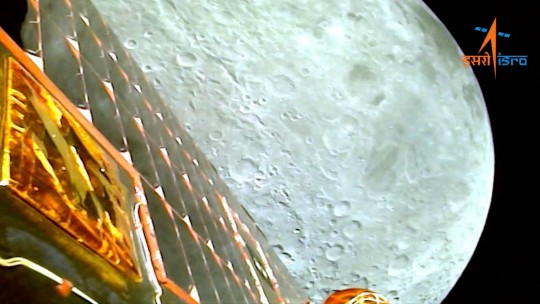
India has landed its Chandrayaan-3 spacecraft on the moon, becoming only the fourth nation ever to accomplish such a feat. The mission could cement India’s status as a global superpower in space. Previously, only the United States, China and the former Soviet Union have completed soft landings on the lunar surface. Chandrayaan-3’s landing site is also closer to the moon’s south pole than any other spacecraft in history has ventured. The south pole region is considered an area of key scientific and strategic interest for spacefaring nations, as scientists believe the region to be home to water ice deposits. The water, frozen in shadowy craters, could be converted into rocket fuel or even drinking water for future crewed missions
Indian Prime Minister Narendra Modi, currently in South Africa for the BRICS Summit, watched the landing virtually and shared broadcasted remarks on the livestream. “On this joyous occasion…I would like to address all the people of the world,” he said. “India’s successful moon mission is not just India’s alone. This is a year in which the world is witnessing India’s G20 presidency. Our approach of one Earth, one family, one future is resonating across the globe. “This human-centric approach that we present and we represent has been welcome universally. Our moon mission is also based on the same human-centric approach,” Modi added. “Therefore, this success belongs to all of humanity, and it will help moon missions by other countries in the future.” India’s attempt to land its spacecraft near the lunar south pole comes just days after another nation’s failed attempt to do the same. Russia’s Luna 25 spacecraft crashed into the moon on August 19 after its engines misfired, ending the country’s first lunar landing attempt in 47 years.
Chandrayaan-3’s journey As Chandrayaan-3 approached the moon, its cameras captured photographs, including one taken on August 20 that India’s space agency shared Tuesday. The image offers a close-up of the moon’s dusty gray terrain. India’s lunar lander consists of three parts: a lander, rover and propulsion module, which provided the spacecraft all the thrust required to traverse the 384,400-kilometer (238,855-mile) void between the moon and Earth. The lander, called Vikram, completed the precision maneuvers required to make a soft touchdown on the lunar surface after it was ejected from the propulsion module. Tucked inside is Pragyan, a small, six-wheeled rover that will deploy from the lander by rolling down a ramp. Vikram used its on board thrusters to carefully orient itself as it approached the lunar surface, and it slowly throttled down its engines for a touchdown just after 6 p.m. IST (8:30 a.m. ET) as applause erupted from the mission control room. The Indian Space Research Organization, or ISRO, later confirmed it had established two-way communication with the spacecraft and shared the first images of the surface captured during the lander’s final descent. The lander, which weighs about 1,700 kilograms (3,748 pounds), and 26-kilogram (57.3-pound) rover are packed with scientific instruments, prepared to capture data to help researchers analyze the lunar surface and deliver fresh insights into its composition.
Dr. Angela Marusiak, an assistant research professor at the University of Arizona’s Lunar and Planetary Laboratory, said she’s particularly excited that the lunar lander includes a seismometer that will attempt to detect quakes within the moon’s interior. Studying how the moon’s inner layers move could be key information for future endeavors on the lunar surface, Marusiak said. “You want to make sure that any potential seismic activity wouldn’t endanger any astronauts,” Marusiak said. “Or, if we were to build structures on the moon, that they would be safe from any seismic activity.” The lander and rover are expected to function for about two weeks on the moon’s surface. The propulsion module will remain in orbit, serving as a relay point for beaming data back to Earth.
2 notes
·
View notes
Text










Retrorockets are special engines designed to fire in the opposite direction of a spacecraft’s movement, slowing it down instead of speeding it up. Unlike regular rockets that push a vehicle forward, retrorockets apply thrust in the opposite direction, helping with landing, reentry, maneuvering, and even emergency escapes.
One of their most famous uses is in landing spacecraft safely. When a lander is approaching the surface of a planet or moon, retrorockets fire to slow it down, ensuring a soft touchdown. The Apollo Lunar Module used them to land on the Moon, and modern landers like those on Mars still rely on them.
Retrorockets are also critical for reentry. When astronauts return to Earth, their capsule is moving at extreme speeds. To prevent burning up in the atmosphere, retrorockets fire to reduce speed before descent. The same principle is used for space maneuvering. When a spacecraft needs to change orbits or dock with another vehicle, retrorockets provide precise control.
Stage separation in multi-stage rockets also depends on retrorockets. When one stage is done, retrorockets fire to push it away, ensuring a clean separation before the next stage ignites. This is how rockets like the Saturn V and Falcon 9 operate efficiently.
Another key application is satellite deorbiting. When a satellite reaches the end of its mission, retrorockets fire to slow it down, making it fall into Earth’s atmosphere, where it burns up instead of becoming space junk.
Retrorockets are even used for emergency escape systems. If a rocket has a problem during launch, small retrorockets can pull the crew capsule away from danger, saving lives.
From safe landings to precise space maneuvers, retrorockets play a vital role in spaceflight. They’re a perfect example of how slowing down at the right time is just as important as speeding up.
Follow for more such educational content daily!
Check, our substack for more in-depth articles on such topics.
#comics#sciencecomics#webcomics#science#stem#educationalcomics#liquidbird#becurious#comicstrips#rockets#space#electronics#aircraft
0 notes
Text
The apollo mission
The mission was apollo 11, the rocket for the apollo mission was Saturn V
The parts of Saturn V:
Command module
Service module
Lunar module
Saturn V rocket
1st stage S-IC has 5 f1 rocket engines
2nd stage S-II has 5 J2 (slightly smaller) rocket engines
3rd stage S-IVB has 1 J2 rocket engine

Lunar module is stored in the top of the rocket, protected by 4 panels called the lunar module adaptors
Service modules contains engines necessary to enter and leave (moon) orbit and fuel cells and other electrical components
Command module is where astronauts spent most of their time

Launch escape system at the very top of the rocket. LES for short. It attaches itself to the command module and takes the astronauts away safely if the rocket were to be damaged or blown up.
As the rocket leaves, the astronauts feel 4x the amount of gravity (pushing them into their seats)
bbq roll
The time and day are very important, it makes sure the moon is in the correct place for their path.
1 of them stays behind in the command module to continue to orbit the moon.
They must be 2 miles away before firing the descent engine.
They must land on flat areas.
Congratulations, you made it to the moon! “One small step for man, one giant leap for mankind!”
The link to the youtube videos that I used to explain:
youtube
youtube
0 notes
Text
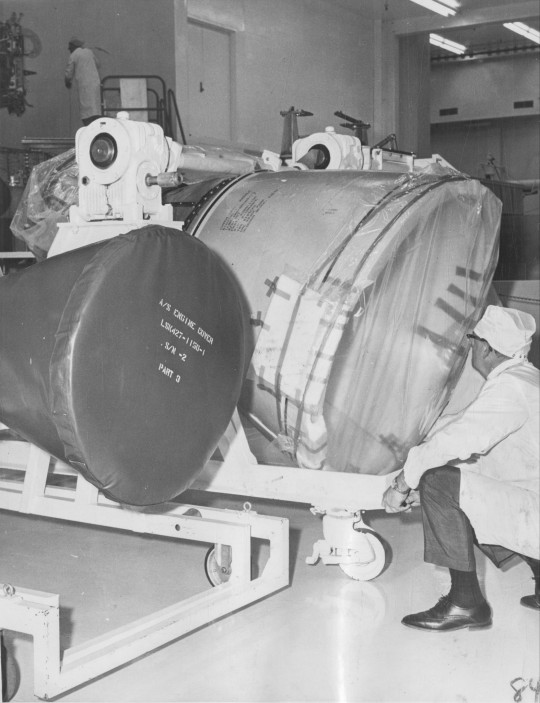
"Program administrator Albert Anderson is seen here with rocket engines involved in the Apollo Lunar Module Project."
Date: May 18, 1967
Long Island Daily Press Identifier: aql:16810 ldp-000238 ldp-000238
#Lunar Module#NASA#Apollo Program#Descent Propulsion System#Lunar Module Descent Engine#LMDE#Lunar descent stage propulsion#TRW VTR-10#Ascent Propulsion System#Lunar Module Ascent Engine#LMAE#Bell/Rocketdyne LMAE#Rocket Engine#Construction#Grumman Aerospace Corporation#Grumman#Factory#Bethpage#Long Island#New York#May#1967#my post
31 notes
·
View notes
Text
Wear The Apollo Mission Control Computer on Your Wrist
The Apollo missions by NASA were some of humanity’s greatest engineering achievements of all time. Sending men to the surface of the moon remains one of humanity’s most ambitious projects, ever. The Display Keyboard (DSKY) was a critical piece of technology that both the Command and Lunar Modules used to navigate and control their descent to the lunar surface. Now, this vintage technology has…
1 note
·
View note
Text
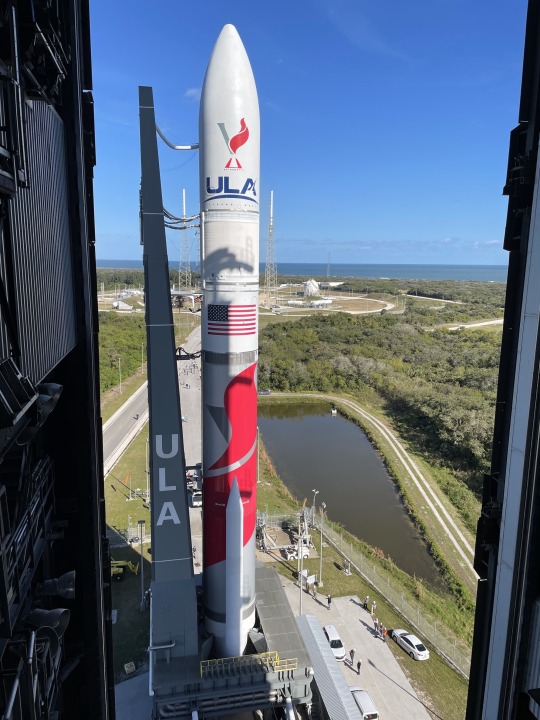
Launching early tomorrow morning (8 Jan), at 07:18GMT, will be the first Vulcan Centaur (V-001), ULA's somewhat belated commercial response to SpaceX's Falcon 9 which began development in 2015, although none of it is reusable (later version might have a recoverable engine module, see below). It can be fitted with 2, 4 or six GEM-63XL SRB which are also now used on the Atlas V (The Atlas V although no longer in production will continue in use until the inventory is used up, the SLC-41 pad can launch either rocket). This launch will also be the first flight of the Blue Origin BE-4 methane/liquid oxygen engine, of which Vulcan has two. Developed jointly with ULA these are comparable to SpaceX's Raptor engines used on Starship. The BE-4 engines will also be used on Blue Origins New Glenn super heavy rocket, a competitor to SpaceX's Starship super heavy.
It will also be the first flight of a Centaur-V, a new 5.4m (18ft) diameter version of the Centaur upper stage powered by two Aerojet Rocketdyne RL-10C-1-1 Liquid Hydrogen/Liquid Oxygen engines.
If that was not enough this will also be the first of NASA's Commercial Lunar Payload Service (CLPS-1) missions, a Lunar landing mission using the Peregrine lander built by Astrobotic Technology. The idea is like the commercial supply mission to the ISS, NASA will buy space onboard Lunar landers built and owned by commercial companies for experiments and ultimately supplies in support of crewed Artemis Lunar missions (more on that if the launch is successful).
Also onboard will be the 20th mission for the Celestis space memorial service. For a large fee you can send the ashes (or at least a small representative sample), and/or their DNA sample, of your departed loved one in a small inscribed canister and depart them further... into space. This mission will include two batches, one on the lander called "Tranquility Flight" and one attached to the Centaur-V upper stage (I presume the container remains attached) which will, once used, go into heliocentric (solar) orbit called "Enterprise Flight". Tranquility Flight will include the DNA of Arthur C. Clarke and Enterprise Flight will include the remains/DNA of Gene Roddenbery and Majel Barrett Roddenbery (Nurse Chapel, Lwaxana Troi and voice of the Ships computer) and the DNA of their living son Eugene "Rod" Roddenberry, James Doohan (Scotty) and his wife Wende and Nichelle Nichols (Nyota Uhura) and her living son Kyle Johnson's DNA. Prices for Earth orbit start from USD4,995 (GBP3,926) and for the Lunar surface service USD12,995. (GBP10,214). Their website did not give the figure for heliocentric orbit (no chance of reentry with that one though).
The Vulcan first stage could in future be fitted with the Sensible Modular Autonomus Return Technology (SMART) system. Were the engine bay of the Vulcan first stage would separate as a module, also containing the launchers avionics, and reenter using an inflatable heatsheild. On descent it will deploy a parafoil before it is air recovered by a large helicopter (a Sikorsky CH53 Sea Stallion or Boeing CH46 Sea Kinight have been shown in graphics). This will recover 65% of the cost of the launcher without the fuel penalty of propulsive stage recovery systems (which ULA considered at the time to be economically unviable...ops!). However nothing has been shown of any development of such hardware since that was first mentioned in 2015. Pic: ULA roll out on 5 Jan.
0 notes
Text
[ad_1] Introduction Chandrayaan-3 is the third and most up-to-date lunar Indian Area Analysis exploration mission beneath the Chandrayaan programme of ISRO. Ofcourse, Chandrayaan-3 isn't just an indication of India’s rising technical capabilities in house exploration but in addition goals to make vital scientific discoveries in an unexplored territory on Moon. As India’s Chandrayaan-3’s mission is on its solution to success, right here’s a flashback from a risk perspective of one of the profitable moon missions on the earth. The Apollo 11 mission is a permanent image of human achievement, marking the primary profitable moon touchdown in historical past. Behind this historic feat lies an intricate internet of threat administration methods that allowed NASA to navigate the complexities of house journey and make sure the security of the astronauts. On this article, we'll delve deep into the teachings realized from the Apollo 11 mission, exploring how NASA’s threat administration method formed its success and the way these classes might be utilized to varied domains. Complete Danger Identification: One of many foundational pillars of NASA’s threat administration method throughout Apollo 11 was the great identification of potential dangers. The mission encompassed a collection of intricate phases, from launch and lunar orbit to the lunar touchdown and the return to Earth. Every of those phases introduced forth a large number of dangers, each recognized and unexpected. Instance 1: Launch Dangers The launch of the Saturn V rocket was fraught with dangers. The explosive potential of the rocket’s gasoline and the intricacies of staging required cautious consideration. To mitigate these dangers, NASA engineers carried out in depth simulations and checks to make sure the rocket’s structural integrity and the reliability of its propulsion techniques. Instance 2: Lunar Touchdown Challenges Touchdown on the moon was an unprecedented endeavor, and the dangers had been magnified by the unknown lunar floor situations. The danger of a crash touchdown was vital. NASA tackled this by using the lunar module’s descent engine to manage the spacecraft’s pace and descent trajectory, permitting Neil Armstrong to pilot the module to a safer touchdown web site when he acknowledged the deliberate web site was strewn with boulders. Prioritizing and Categorizing Dangers: Not all dangers are equal when it comes to their potential influence. NASA employed a threat matrix to categorize dangers based mostly on their severity and chance. This categorization enabled the crew to prioritize their efforts and assets in the direction of addressing essentially the most crucial dangers. Instance 3: Danger Matrix for Astronaut Security Astronaut security was a paramount concern. The danger matrix helped NASA determine potential hazards that might jeopardize the astronauts’ lives. This included dangers associated to life assist techniques, radiation publicity, and gear failures. By specializing in high-impact, high-likelihood dangers, NASA ensured that the astronauts had been adequately protected all through the mission. Innovation and Inventive Downside-Fixing: The Apollo 11 mission demonstrated NASA’s distinctive capability for innovation and inventive problem-solving within the face of surprising challenges. Instance 4: The Lunar Module Pc Anomaly In the course of the lunar descent, the onboard laptop of the lunar module (LM) began receiving extra information than it might course of, triggering a number of alarms and threatening to abort the touchdown. Astronauts Neil Armstrong and Buzz Aldrin needed to shortly assess the scenario and decide to proceed the descent manually. Their means to adapt beneath strain exemplified the significance of human judgment and inventive considering as backup options. Growing Contingency Plans: A core aspect of Apollo 11’s threat administration technique was the event of contingency plans.
These plans had been crucial for making certain the protection of the astronauts and the success of the mission even within the face of surprising occasions. Instance 5: Abort Procedures The Apollo 11 spacecraft had well-defined abort procedures for various phases of the mission. Within the occasion of an emergency throughout launch, lunar orbit, or lunar touchdown, the crew might execute particular maneuvers to securely return to Earth or the command module. These procedures acted as lifelines, offering a transparent plan of action in case of crucial failures. Actual-time Monitoring and Adaptation: Apollo 11’s journey to the moon wasn’t a static, preplanned trajectory. It required steady real-time monitoring and flexibility to answer evolving dangers and challenges. Instance 6: Mid-Course Corrections In the course of the journey to the moon, the spacecraft sometimes required mid-course corrections to make sure correct trajectory. The mission management crew needed to analyze information, assess dangers, and calculate exact maneuvers to maintain the spacecraft on its meant path. This real-time adjustment highlighted the significance of monitoring and responsiveness. Studying from Failures: Tragedy struck NASA with the Apollo 1 accident, during which a cabin fireplace throughout a pre-launch check claimed the lives of astronauts Gus Grissom, Ed White, and Roger Chaffee. This incident emphasised the significance of studying from failures to boost threat administration. Instance 7: The Apollo 1 Tragedy The Apollo 1 catastrophe led NASA to overtake its method to security. The investigation into the incident resulted within the identification of design flaws and procedural inadequacies that contributed to the accident. NASA used this painful lesson to refine security protocols, enhance communication, and develop a security tradition that permeated subsequent missions. Conclusion The Apollo 11 mission stands as a testomony to human dedication, innovation, and risk management. The profitable moon touchdown was not merely a results of luck, however a fastidiously orchestrated dance of meticulous planning, adaptability, and a dedication to astronaut security. The danger administration classes realized from Apollo 11 proceed to resonate throughout industries, demonstrating the worth of thorough risk identification, artistic problem-solving, contingency planning, real-time adaptation, and studying from failures. As we forge forward into new frontiers, the legacy of Apollo 11 serves as a guiding mild for these looking for to handle dangers and obtain the extraordinary. [ad_2]
0 notes
Text
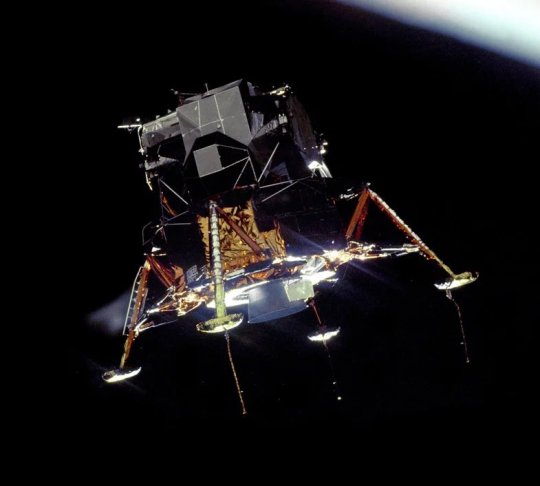
Apollo 15’s LM FALCON experienced the hardest landing out of all of the Apollo missions, at 2.1 meters per second (almost 7 feet per second or 4.77 MPH.). This rough landing left some visible damage on the LMs descent engine when it struck the surface.
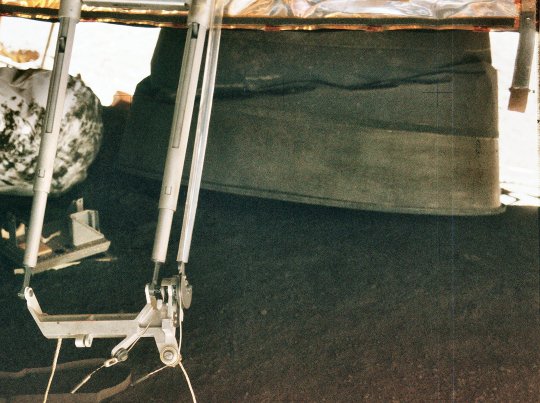
Also, Commander David Scott, unable to see the surface directly under the spacecraft, unknowingly landed on the rim of a small crater causing Falcon to settle at an angle of 6.9 degrees back and 8.6 degrees to the left.
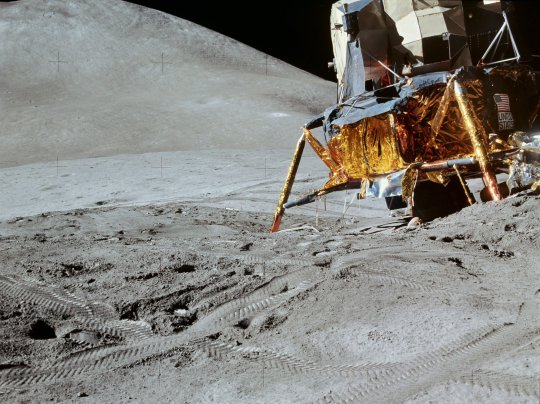
The reason for the damage was due to the fact that the LM for this mission (and the ones that followed) had a larger engine bell than previous missions to increase thrust and accommodate the weight of supplies for a longer stay, experiments, and the Lunar Roving Vehicle.
If the engine were to burn too close to the surface, blowback from lunar regolith could enter into the engine and cause an explosion. NASA warned astronauts of this, so when Lunar Module Pilot Jim Irwin (who was watching the instruments) saw the blue "Lunar Contact" light on the instrument panel come on...

... it meant that one of the LMs probes attached to the legs had touched the surface. He said “contact”, Scott immediately cut the engine and FALCON fell the last five feet.
Any landing you can walk away from, and take off again from, is ok.
0 notes
